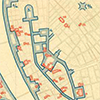In search of resilient urban space
Pest’s city centre at the crossroads of tradition and innovation, 1928–1944
DOI:
https://doi.org/10.18030/socio.hu.2020en.59Kulcsszavak:
urban preservation, townscape, resilience, historical urban neighbourhoodAbsztrakt
In this paper my aim is to examine the Hungarian architectural discourse between 1928 and 1944, with special regard to the ‘historical’ centre of Pest. The observation is carried out through the review of architectural journals and theoretical essays. I undertake a historical analysis of the various uses and changes in the meaning of the concept of townscape. Analysis of the architectural discourse for this time interval might provide a better understanding of the transformation in the perception of urban space.
The examined period can be boldly called the ‘dawn of urban heritage protection’, but also the age of a new urbanity that envisioned the rethinking of urban space through the reconstruction of complete urban areas. This paradox not only had a remarkable impact on rethinking of urban space, especially on determining values, but also led to experimental and hybrid spatial categories. My aim is to study this specific problem of social history, which not only made urban preservation part of the discourse but expanded it more and more as a continually growing ‘set’. This set captures and addresses the diverse aspects of urban life, making the concept of urban heritage even more complex.
The fundamental questions of the study are how the discourse conceptualises urban spatial categories, more precisely, how the materiality of the built environment and representations of space are taken into account. The discourse on compatibility encompasses all strategic behaviours that seek to integrate the historic city and the new architectural solutions incorporating the needs of the present. In order to analyse the ways in which the city centre was constructed in the discourse, I incorporate the resilience model into the argument. Thus, the discussion may help understanding how changes in the interpretation of urban space result in a new attitude towards preservation, development or modernization of ‘historic’ neighbourhoods.






